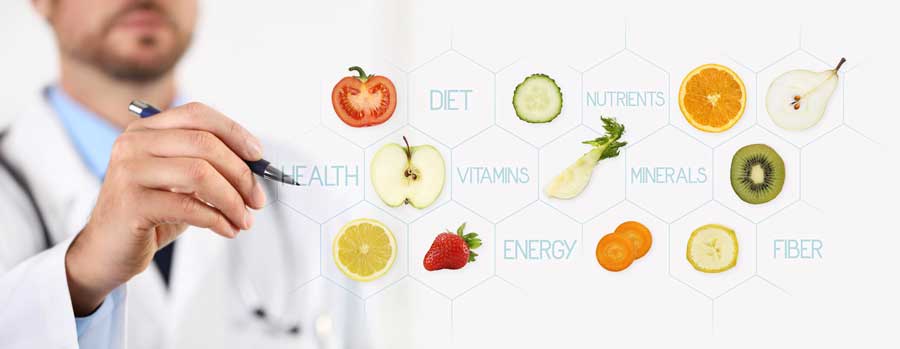Diabetic Meal Plans: Nutrition Tips for Managing Diabetes
Healthy eating is essential for diabetes management. A proper low-sodium diabetic diet plan can help diabetics control weight and manage their blood sugar levels long-term, which can greatly reduce the risk for complications.

So what does a diabetic diet meal plan look like?
A common misconception is that diets for diabetics are restrictive and feature only bland, tasteless food.
But that couldn’t be further from the truth.
Diabetics can still eat many of their favorite foods. In fact, according to the American Diabetes
Association, a diabetic menu should include a variety of delicious foods, like whole grains, fresh fruits
and veggies, lean meats and low- or non-fat dairy. A low-sodium diabetic diet plan should also feature:
- Less high-sugar and processed foods
- Smaller portions spread throughout the day
- Low-fat and non-fat foods
- Less alcohol (which is high in sugar)
- Less salt (i.e. low-sodium foods)
Looking to start a diabetic friendly diet?

MagicKitchen.com’s diabetic meals offers a convenient solution. Our diabetic diet meals are carbohydrate controlled (20-45 grams per meal, on average), low fat, low sodium, easy to reheat and they’re delivered right to your door!
Limiting Carbohydrate on A Diabetic Diet
Our understanding of diabetes meal planning has greatly changed in the last two decades. In the past, a
sugar patient diet plan was highly restrictive, but we now know that macronutrient balance and portion
control are two of the most important considerations.
In particular, when creating a diabetic meal plan, you should focus on three key macronutrients:
- Carbohydrates: Both the American Diabetes Association and the Joslin Diabetes Center recommend moderate carbohydrate meal plans. The ADA recommends about 45% of your daily calories come from carbohydrates, while Joslin recommends 40%.
- Protein: Lean meats, fish and nonfat or low-fat dairy products are ideal sources of proteins which should make up about 20-30% of your daily calories.
- Fat: Fat sources like healthy oils and fatty fish are ideal sources meals that should constitute about 30-35% of your daily calories.
Bottom line, there is no one-size-fits-all diabetic diet. Everyone’s needs are different and can be based on a variety of factors, like activity level, age or weight. Consult with a nutritionist or doctor for personalized macro and micronutrient guidelines.
What Foods Should You Eat as a Diabetic?

As you start meal planning, here’s one important rule: Quality matters. Choosing quality carbs, lean
proteins and natural fats is critical for successful diet planning.
But what constitutes quality? Well, it’s different for every macronutrient, but a good rule of thumb:
Natural, whole foods tend to offer the best nutritional value. In other words, if you can’t recreate a dish
in your kitchen – say a hotdog – it probably doesn’t meet the quality metric.
Here are a few other quality guidelines:
Carbohydrates.
Complex carbohydrates like fresh fruits, veggies, whole grains, legumes and low- or nonfat dairy are more balanced than simple sugars (cereals, cakes, cookies, soda, candy). Your meal plan should include about 8-10 servings of veggies and fruits per day. And focus on high-fiber carbs – like apples, broccoli, or brown rice – which is absorbed by the body more slowly.
Proteins.
Lean proteins, like poultry, nonfat dairy, fish and legumes, should be considered over high-fat proteins. Processed and red meats should be eaten in moderation.
Fats.
Mono and polyunsaturated fats – found in items like olive oil, peanut oil and fish oil – offer better nutritional value than coconut oil, butter and trans fats. Fried foods tend to be high in oils you should avoid.
Micronutrients.
In addition to the macros, you also want to keep any eye on micronutrients, like sodium, fiber and cholesterol. Sodium and cholesterol, for example, can contribute to conditions like hypertension.
Balance Is Key
Balance doesn’t just refer to the variety of foods that you eat. You’ll also want to balance how much and
how frequently you eat. Each meal should include carbs, protein and fat. And you should choose smaller
meals.
In other words, you don’t want to eat just carbs for breakfast and a high-protein lunch. Or snack throughout
the day and then feast at dinnertime.
By balancing your nutritional content of your meals and their frequency, you’ll feel full longer and help to
stabilize your blood sugar levels.
How many carbs should be in each meal? The ADA’s meal planning guidelines recommend a maximum of 45-65 grams
of carbohydrate per meal. For snacks, it’s about 10-20 grams. (All of our diabetic meals meet these
guidelines!)
 Beyond
these guidelines, here are a few other diabetic diet tips for healthy, balanced eating:
Beyond
these guidelines, here are a few other diabetic diet tips for healthy, balanced eating:
- Smaller Meals - Eating more frequent, but smaller meals can help prevent overeating, as well as stabilize blood glucose levels.
- Not Skipping Meals - Skipping meals disrupts blood sugar levels and causes that unhealthy, shaky feeling.
- Eating Until You Feel Full - Overeating can throw your diet out of sync and cause harmful blood sugar crashes.
Special Conditions and Diabetic Meal Planning
Type II Diabetes and Prediabetes are two of the most common types of diabetic diseases in the U.S. And they
affect millions of Americans. For example, 86 million adults in the U.S. have prediabetes, according to the
CDC, and 20 million have been diagnosed with Type II diabetes.
How can you manage each condition?
Lifestyle choices – like healthy eating and exercise – are the best tools for preventing, reducing or
delaying the onset of complications from both these conditions. Weight loss, too, can help to reduce
symptoms.
Here’s a look at both of these special conditions, as well as their dietary considerations:

Type II Diabetes Diet
Type II diabetes is the more progressed version of prediabetes, and its more common than Type I. There are
many risk factors for Type II diabetes. Being overweight, for example, is the No. 1 risk factor, and
inactivity, genetics and age can also increase your risk for developing the disease.
What Is Type II Diabetes: Type II diabetes results when there’s too much sugar in the blood (more so than with prediabetes). As such, the body can’t properly metabolize the sugar, which means your blood sugar stays abnormally high for long periods of time. Over the long-term, high blood glucose can have many complications, including kidney, eye, nerve and heart damage.
How Diet Can Help: Since Type II diabetes affects how your body metabolizes sugar,
limiting your carbohydrate intake can help the body better manage blood glucose levels. The Type II diabetes
diet typically focuses on limiting and reducing simple carbohydrates like cookies, cakes and refined sugars,
for example.
Overall, the goal of the diet is to balance your blood glucose levels. But since weight is such a
significant contributing factor, Type II diets tend to also focus on sustainable, long-term weight loss.
Most meal plans focus on controlling carbs per meal – focusing on a maximum of 65 grams of carbs per meal –
as well as increasing intake of high-fiber, complex carbohydrates like leafy greens, broccoli, whole-grain
breads, and legumes.
Prediabetes Diet
People with prediabetes are at a high risk for developing Type II diabetes. In fact, according to the Mayo
Clinic, people who have been diagnosed as prediabetic tend to develop the more progressive version within 10
years. Like Type II diabetes, factors like obesity and a sedentary lifestyle are major contributing
factors.
What Is Prediabetes: Prediabetes is very similar to Type II diabetes, in that the body struggles to properly metabolize sugars. The difference: Prediabetics have more moderate (although still heightened) levels of sugar in the blood, and although the body struggles to metabolize sugars, it is still more efficient than those with diabetes.
How Diet Can Help: A prediabetes diet focuses on two goals: 1) Reducing carbohydrates and 2) weight loss. Therefore, the diet is similar to the traditional diabetes diet, in that simple sugars like cereals, cookies, etc. are reduced, meals are balanced throughout the day, and portions should be monitored.
In particular, people who have been diagnosed as prediabetic should watch out for high-glycemic foods. These are foods that are usually processed or canned, and often include highly refined carbohydrates. Sodas, juices, white bread, and chocolate – for example – are all high GI foods.
Low-Carb Meal Plan for Diabetes

Restricting carbohydrate intake is one of the most common methods for treating diabetes. In fact, low-carb
meal plans were the primary treatment for diabetes prior to the discovery of insulin in the 1920s.
How many grams of carbohydrate do low-carb diets include? It depends on who you ask. Some restrict carbs to
just 20-30 grams per day – about the amount of an apple – while others follow a more moderate intake of 20%
of one’s daily calories. (That’s compared to the ADA’s recommendation of 45%.)
What foods can you eat? High-protein and high-fat foods are your friends. Choose foods like:
- Meat, poultry, seafood
- Eggs, egg substitutes
- Green, above-the-ground veggies
- Avocados (high in healthy fats)
- Olive oil, butter, heavy cream
- Cheese and low-fat dairy
Does a Low-Carb Diet Work? Research shows this type of diet can help diabetes patients
long-term. Several studies have examined how a low-carb diet helped diabetic manage blood sugar, and many
have showed long-term maintenance, when followed properly. Low-carb diets may also help with weight control.
Ultimately, low-carb diets aren’t for everyone. If you’re considering a low-carb diet, talk with your doctor
or nutritionist.
Diabetic Friendly Meals Delivered to Your Door
MagicKitchen.com offers low-sodium diabetic diet plans for delivery. Our diabetic meals are nutritious, delicious and delivered right to your door! Our menu options are:
- Carbohydrate controlled (20-45 grams per meal, on average)
- Low in sodium (fewer than 700 mg per meal)
- Nutrient balanced (protein, carbs and healthy fats in every meal)
- Reheat in minutes
Browse our menu of diabetic meals today!
Our Other Meal Options
Low Carb Meal Delivery
Healthy Meal Delivery
Dialysis Meal Delivery
Gluten Free Meal Delivery
Diabetic Meal Delivery
1200 Calorie a Day Diet



 INSURANCE CUSTOMERS CLICK HERE!
INSURANCE CUSTOMERS CLICK HERE!
